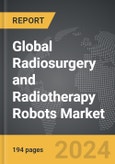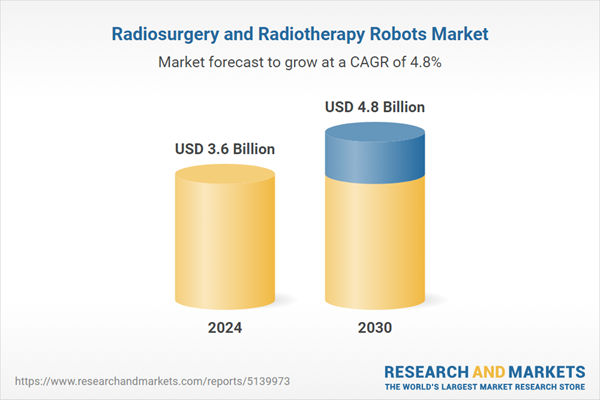The global market for Radiosurgery and Radiotherapy Robots was valued at US$3.6 Billion in 2024 and is projected to reach US$4.8 Billion by 2030, growing at a CAGR of 4.8% from 2024 to 2030. This comprehensive report provides an in-depth analysis of market trends, drivers, and forecasts, helping you make informed business decisions. The report includes the most recent global tariff developments and how they impact the Radiosurgery and Radiotherapy Robots market.
Segments: Type (X-Ray Based Robots, Gamma-Ray Based Robots).
Geographic Regions/Countries: World; United States; Canada; Japan; China; Europe (France; Germany; Italy; United Kingdom; and Rest of Europe); Asia-Pacific; Rest of World.
The analysts continuously track trade developments worldwide, drawing insights from leading global economists and over 200 industry and policy institutions, including think tanks, trade organizations, and national economic advisory bodies. This intelligence is integrated into forecasting models to provide timely, data-driven analysis of emerging risks and opportunities.
Global Radiosurgery and Radiotherapy Robots Market - Key Trends and Drivers Summarized
Radiosurgery and Radiotherapy Robots: Revolutionizing Cancer Treatment with Precision
Radiosurgery and radiotherapy robots represent a significant advancement in the field of oncology, offering highly precise and minimally invasive treatment options for cancer patients. These robots are designed to deliver targeted radiation to cancerous tissues while minimizing exposure to surrounding healthy tissues. This precision is achieved through advanced imaging technologies and robotic arms that can adjust to the slightest movement of the patient, ensuring accurate delivery of radiation. Radiosurgery, often performed using systems like the CyberKnife, is particularly effective in treating small tumors or metastases, while radiotherapy robots, such as the TrueBeam, are used for a broader range of cancer types. These technologies are transforming the landscape of cancer treatment, providing options for patients who may not be candidates for traditional surgery.What Technological Innovations Are Driving the Evolution of Radiosurgery and Radiotherapy Robots?
The evolution of radiosurgery and radiotherapy robots has been driven by several technological innovations that have enhanced their precision, efficiency, and safety. The integration of real-time imaging technologies, such as MRI and CT scans, with robotic systems allows for continuous monitoring of the tumor and surrounding tissues during treatment. This ensures that radiation is delivered with pinpoint accuracy, even in tumors that move due to breathing or other physiological processes. Advanced software algorithms have also improved the planning and execution of treatments, enabling customized radiation doses based on the specific characteristics of the tumor. Furthermore, developments in robotics have enhanced the flexibility and range of motion of these systems, allowing them to treat tumors in difficult-to-reach areas. These technological advancements are making radiosurgery and radiotherapy more effective and accessible, improving outcomes for cancer patients worldwide.What Are the Key Applications and Benefits of Radiosurgery and Radiotherapy Robots in Oncology?
Radiosurgery and radiotherapy robots are used in a wide range of oncology applications, offering numerous benefits that enhance the effectiveness and safety of cancer treatment. Radiosurgery robots are particularly beneficial for treating brain tumors, spinal tumors, and small metastatic lesions, where precision is critical to avoid damage to surrounding neural structures. Radiotherapy robots, on the other hand, are used for treating larger tumors in areas such as the lung, prostate, and breast, where they can deliver high doses of radiation with minimal side effects. The primary benefits of these robotic systems include reduced treatment times, minimized radiation exposure to healthy tissues, and the ability to treat patients who are not candidates for surgery. Additionally, the non-invasive nature of radiosurgery and radiotherapy robots reduces the risk of complications and shortens recovery times, improving the overall patient experience.What Factors Are Driving the Growth in the Radiosurgery and Radiotherapy Robots Market?
The growth in the Radiosurgery and Radiotherapy Robots market is driven by several factors. The increasing prevalence of cancer globally is a significant driver, as more patients seek advanced treatment options that offer better outcomes with fewer side effects. Technological advancements in imaging, robotics, and treatment planning are also propelling market growth by enhancing the precision and effectiveness of these systems. The rising adoption of minimally invasive treatments is further boosting demand for radiosurgery and radiotherapy robots, as patients and healthcare providers increasingly prefer treatments that offer quicker recovery times and lower risks of complications. Additionally, the expansion of healthcare infrastructure in emerging markets is contributing to market growth, as more healthcare facilities invest in advanced oncology technologies to meet the growing demand for cancer treatment. These factors, combined with continuous innovation in cancer treatment technologies, are driving the sustained growth of the Radiosurgery and Radiotherapy Robots market.Report Scope
The report analyzes the Radiosurgery and Radiotherapy Robots market, presented in terms of units. The analysis covers the key segments and geographic regions outlined below.Segments: Type (X-Ray Based Robots, Gamma-Ray Based Robots).
Geographic Regions/Countries: World; United States; Canada; Japan; China; Europe (France; Germany; Italy; United Kingdom; and Rest of Europe); Asia-Pacific; Rest of World.
Key Insights:
- Market Growth: Understand the significant growth trajectory of the X-Ray Based Robots segment, which is expected to reach US$3.2 Billion by 2030 with a CAGR of a 5.3%. The Gamma-Ray Based Robots segment is also set to grow at 3.8% CAGR over the analysis period.
- Regional Analysis: Gain insights into the U.S. market, valued at $976.5 Million in 2024, and China, forecasted to grow at an impressive 4.4% CAGR to reach $750.7 Million by 2030. Discover growth trends in other key regions, including Japan, Canada, Germany, and the Asia-Pacific.
Why You Should Buy This Report:
- Detailed Market Analysis: Access a thorough analysis of the Global Radiosurgery and Radiotherapy Robots Market, covering all major geographic regions and market segments.
- Competitive Insights: Get an overview of the competitive landscape, including the market presence of major players across different geographies.
- Future Trends and Drivers: Understand the key trends and drivers shaping the future of the Global Radiosurgery and Radiotherapy Robots Market.
- Actionable Insights: Benefit from actionable insights that can help you identify new revenue opportunities and make strategic business decisions.
Key Questions Answered:
- How is the Global Radiosurgery and Radiotherapy Robots Market expected to evolve by 2030?
- What are the main drivers and restraints affecting the market?
- Which market segments will grow the most over the forecast period?
- How will market shares for different regions and segments change by 2030?
- Who are the leading players in the market, and what are their prospects?
Report Features:
- Comprehensive Market Data: Independent analysis of annual sales and market forecasts in US$ Million from 2024 to 2030.
- In-Depth Regional Analysis: Detailed insights into key markets, including the U.S., China, Japan, Canada, Europe, Asia-Pacific, Latin America, Middle East, and Africa.
- Company Profiles: Coverage of players such as Accuray, Inc., Best Theratronics Ltd., BrainLab AG, Elekta AB, Huiheng Medical, Inc. and more.
- Complimentary Updates: Receive free report updates for one year to keep you informed of the latest market developments.
Some of the 42 companies featured in this Radiosurgery and Radiotherapy Robots market report include:
- Accuray, Inc.
- Best Theratronics Ltd.
- BrainLab AG
- Elekta AB
- Huiheng Medical, Inc.
- Masep Medical Science & Technology Development (Shenzhen) Co., Ltd.
- Neusoft Medical Systems Co., Ltd.
- Varian Medical Systems, Inc.
- ViewRay, Inc.
Tariff Impact Analysis: Key Insights for 2025
Global tariff negotiations across 180+ countries are reshaping supply chains, costs, and competitiveness. This report reflects the latest developments as of April 2025 and incorporates forward-looking insights into the market outlook.The analysts continuously track trade developments worldwide, drawing insights from leading global economists and over 200 industry and policy institutions, including think tanks, trade organizations, and national economic advisory bodies. This intelligence is integrated into forecasting models to provide timely, data-driven analysis of emerging risks and opportunities.
What’s Included in This Edition:
- Tariff-adjusted market forecasts by region and segment
- Analysis of cost and supply chain implications by sourcing and trade exposure
- Strategic insights into geographic shifts
Buyers receive a free July 2025 update with:
- Finalized tariff impacts and new trade agreement effects
- Updated projections reflecting global sourcing and cost shifts
- Expanded country-specific coverage across the industry
Table of Contents
I. METHODOLOGYII. EXECUTIVE SUMMARY2. FOCUS ON SELECT PLAYERSIII. MARKET ANALYSISIV. COMPETITION
1. MARKET OVERVIEW
3. MARKET TRENDS & DRIVERS
4. GLOBAL MARKET PERSPECTIVE
UNITED STATES
CANADA
JAPAN
CHINA
EUROPE
FRANCE
GERMANY
ITALY
UNITED KINGDOM
REST OF EUROPE
ASIA-PACIFIC
REST OF WORLD
Companies Mentioned (Partial List)
A selection of companies mentioned in this report includes, but is not limited to:
- Accuray, Inc.
- Best Theratronics Ltd.
- BrainLab AG
- Elekta AB
- Huiheng Medical, Inc.
- Masep Medical Science & Technology Development (Shenzhen) Co., Ltd.
- Neusoft Medical Systems Co., Ltd.
- Varian Medical Systems, Inc.
- ViewRay, Inc.
Table Information
| Report Attribute | Details |
|---|---|
| No. of Pages | 194 |
| Published | April 2025 |
| Forecast Period | 2024 - 2030 |
| Estimated Market Value ( USD | $ 3.6 Billion |
| Forecasted Market Value ( USD | $ 4.8 Billion |
| Compound Annual Growth Rate | 4.8% |
| Regions Covered | Global |









